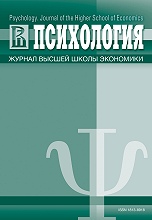Spatial Autocorrelation of Educational Attainment in the Russian Federation
Keywords:
spatial autocorrelation, educational attainments, net migration
Abstract
Spatial autocorrelation is a measure of the degree in which objects, situated in a close proximity, have a tendency for similar values of a given index. Since recently psychology started to study spatial autocorrelation of national IQ (mean intelligence in a country). The article presents the results of the calculation of spatial autocorrelation of educational attainment (calculated from a mean score of the Unified National Exam of young people, who made it into a college for a budget education in 2014), as well as crime, birthrate, infant mortality, urbanization, net migration and personal income for 75 regions (subjects) of the Russian Federation. These results showed that, though all the mentioned indices are characterized by the spatial autocorrelation, its value varies. Low spatial autocorrelation has net migration, which is probably due to the fact that even a slight difference in life conditions between neighbor regions may promote intensive migration from the region with the worse conditions to the regions with better conditions, including the neighboring one. Low spatial autocorrelation of personal income can be explained by the fact that in the Russian Federation personal income in the region to a great extent is determined by oil and gas production, while mineral deposits are hardly characterized by the spatial autocorrelation on the level of such territorial units as subjects of the Russian Federation. Spatial autocorrelation of educational attainment is probably lessened by the fact that the scores were received by averaging the scores of the Unified National Exam for all specialties of all universities of the region without the consideration of possible differences of regions in prestige value of specialties and number of budget places in universities.Downloads
Download data is not yet available.
References
1. Gelade, G. A. (2008). The geography of IQ. Intelligence, 36,495-501. https://doi.org/10.1016/ j.intell.2008.01.004
2. Grigoriev, A. A., & Sukhanovskii, V. Yu. (2015). Geografiya nauchnogo tvorchestva [The geography of scientific creativity]. In A. L. Zhuravlev, D. V. Ushakov, & M. A. Kholodnaya (Eds.), Sovremennye issledovaniya intellekta i tvorchestva[Modern studies of intelligence and creativity] (pp. 172-188). Moscow: Institute of Psychology of RAS.
3. Grigoriev, A. A., Lapteva, E. M., & Ushakov, D. V. (2015). Educational performance of Moscow region districts reproduce their literacy level in the XIX century: mechanisms of the “cultural genetics”. Siberian Journal of Psychology, 56, 69-85. (in Russian)
4. Grigoriev, A., Ushakov, D., Valueva, E., Zirenko, M., & Lynn, R. (2016). Differences in educational attainment, socio-economic variables and geographical location across 79 provinces of the Russian Federation. Intelligence, 58, 14-17. https://doi.org/10.1016/j.intell.2016.05.008
5. Hassall, C., & Sherratt, T. (2011). Statistical inference and spatial patterns in correlates of IQ. Intelligence, 39(5), 303-310. https://doi.org/10.1016/j.intell.2011.05.001
6. Regiony Rossii. Social’no-jekonomicheskie pokazateli. 2013 [Regions of Russia. Social economic indices]. (2013). Retrieved from http://www.gks.ru/wps/wcm/connect/rosstat_main/rosstat/ru/statistics/publications/catalog/doc_1138623506156
7. The Ministry of Education and Science of the Russian Federation. (2014). Kachestvo byudzhetnogo priema v gosudarstvennye vuzy RF po napravleniyam podgotovki - 2014 [The quality of budget admissions to the state universities of the Russian Federation according to the training program -2014]. Retrieved from http://vid1.rian.ru/ig/ratings/kachestvopriema_napravleniya_budget_2014.pdf
2. Grigoriev, A. A., & Sukhanovskii, V. Yu. (2015). Geografiya nauchnogo tvorchestva [The geography of scientific creativity]. In A. L. Zhuravlev, D. V. Ushakov, & M. A. Kholodnaya (Eds.), Sovremennye issledovaniya intellekta i tvorchestva[Modern studies of intelligence and creativity] (pp. 172-188). Moscow: Institute of Psychology of RAS.
3. Grigoriev, A. A., Lapteva, E. M., & Ushakov, D. V. (2015). Educational performance of Moscow region districts reproduce their literacy level in the XIX century: mechanisms of the “cultural genetics”. Siberian Journal of Psychology, 56, 69-85. (in Russian)
4. Grigoriev, A., Ushakov, D., Valueva, E., Zirenko, M., & Lynn, R. (2016). Differences in educational attainment, socio-economic variables and geographical location across 79 provinces of the Russian Federation. Intelligence, 58, 14-17. https://doi.org/10.1016/j.intell.2016.05.008
5. Hassall, C., & Sherratt, T. (2011). Statistical inference and spatial patterns in correlates of IQ. Intelligence, 39(5), 303-310. https://doi.org/10.1016/j.intell.2011.05.001
6. Regiony Rossii. Social’no-jekonomicheskie pokazateli. 2013 [Regions of Russia. Social economic indices]. (2013). Retrieved from http://www.gks.ru/wps/wcm/connect/rosstat_main/rosstat/ru/statistics/publications/catalog/doc_1138623506156
7. The Ministry of Education and Science of the Russian Federation. (2014). Kachestvo byudzhetnogo priema v gosudarstvennye vuzy RF po napravleniyam podgotovki - 2014 [The quality of budget admissions to the state universities of the Russian Federation according to the training program -2014]. Retrieved from http://vid1.rian.ru/ig/ratings/kachestvopriema_napravleniya_budget_2014.pdf
Published
2018-11-05
How to Cite
ГригорьевА. А. (2018). Spatial Autocorrelation of Educational Attainment in the Russian Federation. Psychology. Journal of the Higher School of Economics, 15(1), 164-173. https://doi.org/10.17323/1813-8918-2018-1-164-173
Issue
Section
Work in Progress





